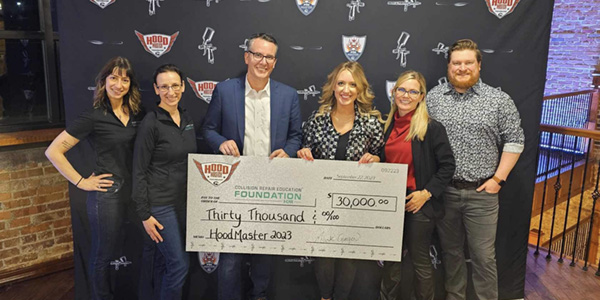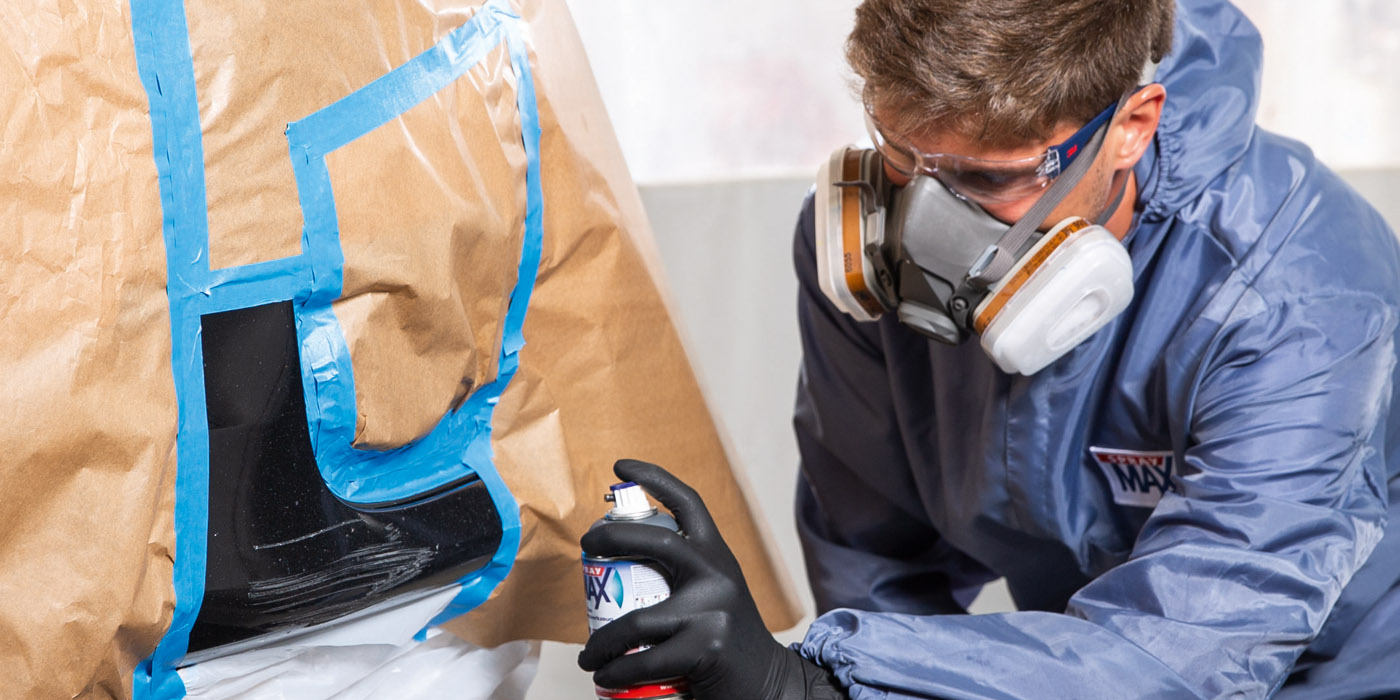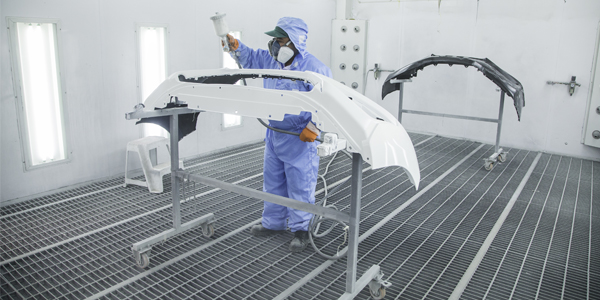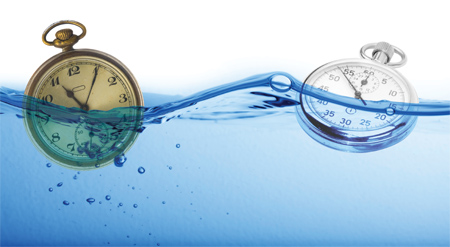
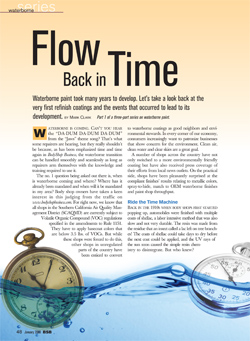
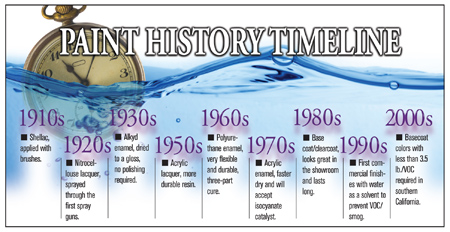 Waterborne is coming. Can’t you hear the “DA-DUM DA-DUM DA-DUM” from the “Jaws” theme song? That’s what some repairers are hearing, but they really shouldn’t be because, as has been emphasized time and time again in BodyShop Business, the waterborne transition can be handled smoothly and seamlessly as long as repairers arm themselves with the knowledge and training required to use it.
Waterborne is coming. Can’t you hear the “DA-DUM DA-DUM DA-DUM” from the “Jaws” theme song? That’s what some repairers are hearing, but they really shouldn’t be because, as has been emphasized time and time again in BodyShop Business, the waterborne transition can be handled smoothly and seamlessly as long as repairers arm themselves with the knowledge and training required to use it.
The No. 1 question being asked out there is, when is waterborne coming and where? Where has it already been mandated and when will it be mandated in my area? Body shop owners have taken a keen interest in this judging from the traffic on www.bodyshopbusiness.com. For right now, we know that all shops in the Southern California Air Quality Management District (SCAQMD) are currently subject to Volatile Organic Compound (VOC) regulations specified in the amendments to Rule 1151. They have to apply basecoat colors that are below 3.5 lbs. of VOCs. But while these shops were forced to do this, other shops in unregulated parts of the country have been enticed to convert to waterborne coatings as good neighbors and environmental stewards. In every corner of our economy, consumers increasingly want to patronize businesses that show concern for the environment. Clean air, clean water and clear skies are a great goal.
A number of shops across the country have not only switched to a more environmentally friendly coating but have also received press coverage of their efforts from local news outlets. On the practical side, shops have been pleasantly surprised at the compliant finishes’ results relating to metallic colors, spray-to-hide, match to OEM waterborne finishes and paint shop throughput.
Ride the Time Machine
Back in the 1910s when body shops first started popping up, automobiles were finished with multiple coats of shellac, a labor intensive method that was also slow and not very durable. The resin was made from the residue that an insect called a lac left on tree branches! The coats of shellac could take days to dry before the next coat could be applied, and the UV rays of the sun soon caused the simple resin chemistry to disintegrate. But who knew?
Cars had only been around for a few years.
In the 1920s, the first of many quantum leaps in refinish paint chemistry occurred. Depending on who you talk to, nitrocellulose lacquer was an offshoot of explosives manufacturing for World War I (gun cotton was made by boiling cellulose fiber and nitric acid) or early motion pictures (celluloid film was also made by boiling plant fibers down to a sticky resin.) In either case, the chemistry allowed paint companies to make a lacquer resin that dried quickly, was much more durable than shellac in the sunshine and could soon be created in colors other than black. However, it dried so fast you couldn’t brush it smooth; it had to be sprayed. A Toledo, Ohio, ear, nose and throat doctor took what he learned from inventing the atomizer to disperse medicine in vapor form and invented the first spray gun. Thanks, Dr. DeVilbiss.
Lacquer and Enamel
Within the solvent-based paint world, there are only two kinds of paint: lacquer and enamel. The finishes we all use so effectively today are a special type of enamel that adds a catalyst that causes the resin to crosslink and form a super durable, high-gloss paint film.
Lacquer paints dry in a single operation, the evaporation of the solvent (lacquer thinner). Time has no effect, and any lacquer film can be re-softened by the addition of more solvent. The Egyptians used something like nitrocellulose (plant fiber resin) lacquer 3,000 years ago. A rag soaked in today’s slow dry lacquer thinner would immediately soften up the finish on an Egyptian casket, even after thousands of years of dry time.
Enamel resins dry in two steps: the evaporation of the solvent (enamel reducer) and the oxidation of the resin by contact with air. That’s why we still tell people not to wax their car for 30 days. It can take that long for the enamel resin to complete the curing process. If the paint is waxed, no air can get to the resin.
Today’s urethane enamel resins cure in three steps: evaporation of the reducer, oxidation of the resin and an irreversible crosslink with part A (resin and catalyst) and part B (isocyanate hardener) form new compound C (cured paint film.) Waterborne finishes are different animals. The resin isn’t dissolved in the solvent but dispersed in the water. It dries and cures when the water evaporates and the polymer particles coalesce (melt) into each other.
Body shops entered the next revolution in the 1930s with alkyd enamels. Alkyd or synthetic paint resins were still made from plants found in nature (sunflower oil, soybean oil, other vegetable oils) but were extracted and combined with much greater chemical skill. The big advantage to auto refinishers was that the enamel resin dried slowly enough to form a nice gloss. Lacquer resins dried so quickly they had to be polished to a gloss. Granted, the door rate was a fraction of today’s labor charges, but it still took a long time to buff out a big truck with rubbing compound.
Alkyd enamel finishes needed a cleaner spray environment; any dust or dirt stuck quickly in the slower drying paint film, and that happenstance marked the beginning of enclosed paint booths. The upside was the shop could spray paint the car with three coats of paint and deliver the finished job the next day. The 1930s were also the first time that reflectents were added to auto paint. The irregular shaped aluminum dregs from roof coatings were added to synthetic enamel to give it sparkle on high-dollar cars like Packards and Cadillacs.
The next change in auto refinish came in the 1950s with the invention of acrylic lacquers. While these paints still dried in a single step (evaporation of the solvents), the paint film was much more durable and easier to work with. It was just like they told Benjamin Braddock in the movie, “The Graduate”: “PLASTICS.” Acrylic is just another name for a resin formulated and created in a laboratory rather than just extracted from plants. These hydrocarbon-based polymers markedly outperformed the “squeezin’s” from plants. This new type of lacquer still had to be buffed to a gloss but was much longer lasting in the sunshine. Auto paint by these days routinely contained special “metallic” or “polychromatic” reflective flakes made by Alcoa Aluminum in several sizes that gave a snazzy sparkle to affordable cars like Plymouths, Fords and Chevys.
Poly Means Many
The late 1960s saw the first refinish uses of polyurethane enamels on fleets of trucks and buses. “Poly” is a Greek word that means “many,” so polyurethane enamel was made from a mix of many resins (acrylic, alkyd, epoxy, polyester, etc.) and dried in three stages, the most important being the chemical crosslink of the hardener and the paint resin. This unbelievably durable chemistry enabled airplane paints to withstand the temperature change encountered when the planes took off from scorching hot runways in Arizona and, within seconds, were thousands of feet in the below-zero atmosphere. Other desirable qualities could be formulated into the polyurethane resins, too, such as the ability to create a slick top surface on city busses so graffiti could be wiped off without damaging the paint. The paint could also be made so flexible that it could withstand an impact from large road debris and not crack.
The early 1970s brought acrylic enamel into refinish. Just like the extra durability manmade resins brought to lacquer paints in the ’50s, acrylic enamel outperformed straight alkyd enamel resins (although many refinish acrylic enamels were actually a blend of alkyd and acrylic resins.) These paints were much faster drying than straight alkyd enamel, and the finishes could be kept clean more easily. The more sophisticated paint resin also allowed the use of an isocyanate catalyst to crosslink and provided a urethane (definition: crosslink) reaction.
Auto refinishing demands different qualities from paint than fleet use does. An auto finish has to be soft enough to allow the polishing out of dust and minor imperfections and be capable of blending into itself. Fleet finishes are most often panel painted and seldom blended onto surrounding panels. The same chemical trickery that allows graffiti to be wiped off a bus means the finish is too hard to polish easily.
The 1980s brought basecoat/clearcoat finishes. The consumer preference for these finishes caught on fast. Although the OEMs had to paint the car twice, once for the color and once for the durable clear, these finishes sold cars – not to mention the end product was more durable. This was also the first time that something besides aluminum flake was added to factory paint jobs to create a sparkle. These pearlescent flakes reflected some light, like aluminum, but also transmitted some light through the chip of powdered-coated mica to create a color change similar to the inside of a seashell. Separating the color coats from the durable topcoats (clear) allowed for more control of any special effect pigments.
Water Flows
The early 1990s saw the first commercial waterborne automotive paints. Although the earliest efforts to create them dated back to the late 1970s, it took 20 years to make them viable. They were created in anticipation of the air quality rules in the United Kingdom (1995) soon to be adopted by the rest of the European Union (1998). These paints have as much as eight times less VOC levels than solventborne.
Regulations in Europe differ from those in the SCAQMD. For one, Europe’s control measures are not specified in pounds per gallon but rather grams per liter. For another, the European Union regulations don’t recognize any “exempt” solvents. Water is the only exempt solvent by its standards. In the SCAQMD, several solvents are listed as exempt and don’t count toward the total VOC calculation (i.e. acetone, methyl acetate, T-butyl acetate).
While we can call any solventborne finish a lacquer or enamel, waterborne is different. Water suspends the resin polymers rather than dissolves them. And while the difference in Brand A lacquer and Brand B lacquer is small, the difference in methods to make waterborne finishes is broader. You can use several distinct chemistries or a variety of chemical combinations to include non-polluting water as a carrying or transfer agent in meeting the California Air Resources Board (CARB) regulations.
Smog City
Because so many people live, work and drive in southern California, that region has some of the worst air quality in the United States. This brown-colored air is really ground-level ozone, but it’s most often called smog. Smog in Los Angeles is the result of VOCs reacting with sunlight to form a haze in the air. Automobile exhaust is still the main culprit, but paints and solvents have been identified as contributing approximately 12 percent to the overall VOC pollution.
Efforts to improve the air quality have been ongoing since the 1960s. In 1988, the SCAQMD passed Rule 1151 aimed at minimizing the amount of VOCs pumped into the Southern California atmosphere. Many shops remember Rule 1151, as this was the impetus for high-volume, low-pressure (HVLP) spray guns. The original rule called for anyone spraying anything within their jurisdiction to use spray equipment that had at least 65 percent transfer efficiency.
Effective July 1, 2008, Rule 1151 was amended to control the VOC content of both basecoat and clearcoat finishes. Prior to the amendment, the paint shops within the SCAQMD could “stack” the two coatings to achieve suitable VOC levels. Original rules said that the basecoat and the clearcoat together could have no more than 3.5 lbs. of VOCs per gallon of paint. Existing solventborne basecoats typically have 5.0 to 6.0 lbs. of VOC, and shops were able to comply by using very high solids (2.1 lb./gal.) clearcoats. The new rules call for the clearcoats applied within the SCAQMD to have no more than 2.1 lbs. of VOC and the basecoats to have no more than 3.5 lb./gal. of VOC.
The amendments specify VOC content for most every coating used in refinish (primers, single-stage color, bedliners, etc.) and will call for meeting new product guidelines each year until all coatings have been addressed. Affected shops had until January 1, 2009 to use up all their existing solvent materials and must not use, or even possess, non-compliant coatings after that date.
Two basic types of basecoat finish can meet the new rules. Several paint companies have a solvent-based system that has less than 3.5lb./gal. of VOCs due to their use of many exempt solvents. The SCAQMD says acetone doesn’t react with sunlight to form smog, so a paint company can use all it wants. The other method is to add water (no VOC at all) to the paint resin. Waterborne chemistry can take several different routes.
Mark the Date
Jan. 1, 2009 – By this date, shops in the SCAQMD were required to use up all their existing solvent materials and not use, or even possess, non-compliant coatings after that date.
2010 – Canada has plans to implement VOC basecoat and clearcoat requirements similar to California’s as soon as 2010; actual dates and requirements have not been finalized.
2012 – The Northeast Ozone Transportation Commission (OTC) comprising 12 eastern states and the District of Columbia has proposed adopting the California Air Resources Board control measures by Jan. 1, 2012. Several paint manufacturers predict the OTC will adopt a common rule, but implementation dates and strategies may differ from state to state.
???? – The Lake Michigan Air Directors Consortium comprises a group of four states around Lake Michigan that many predict will eventually mandate similar VOC content rules.
Oil and Vinegar
I interviewed chemists from all the leading refinish paint manufacturers for this story. Everyone was very gracious with their time and knowledge, and let me be the first to say that there are some really smart chemists working in our business! Once again, I wished I hadn’t slept though high school chemistry class.
Several of my interviewees likened the issue of water in auto paint to salad dressing. The oil and the vinegar don’t like each other and don’t readily mix together. How each paint manufacturer gets the polymers to stabilize in the can and then coalesce into a durable film is some real chemical wizardry.
Lacquer is a reversible dry: add more solvent, and the finish softens up. Waterborne is semi-reversible, depending on the chemical path used in construction of the resin. If waterborne paints are really soluble with more water, they’ll wash off the car in the rain. If they’re completely impervious to re-softening (insoluble), the basecoat will be so slick and hard that the clearcoat won’t adhere well.
Another good reason to stay within one brand of paint, each manufacturer is committed to producing a BC/CC system that is chemically compatible. They’re unconcerned that their color or their clear work with the competitor’s products. Just like always, don’t mix the Brand A basecoat with the Brand B clearcoat. Chemical compatibility is even more important these days because, while Brand A lacquer and Brand B lacquer were pretty darn similar, the trip down a waterborne automotive refinish road has several paths.
Getting the water and the solvent resins to mix is tough. Oil and water don’t mix, right? You can make them mix with each other in several different ways. I had chemists talk to me about hydrophobic (water-hating) and hydrophilic (water-loving) resins. They also told me about using surfactants (soaps) to stabilize and get the two resins to flow together. They explained that their resins were core-shells and had tendrils like amoebas that tangled with each other and kept the component parts from settling out. Emulsion polymerization, maximum incremental reactivity, rheological control, polymer molecular chains, stabilized dispersant technology, ionic acidity, by electric charge or surfactant repulsion. Help, my head hurts!
Here’s one explanation I was offered of the difference in lacquer, urethane enamel and waterborne that made sense to me. Think of a lacquer paint film as made up of individual bricks laid next to each other. Think of a urethane enamel paint film as bricks laid next to each other and mortared together at the seams. Think of a waterborne paint film as bricks laid next to each other that literally melt into one another as they dry to form one big, seamless brick. Some chemistries add a catalyst to their waterborne paint film, which would be the one continuous brick with mortar in any hairline cracks.
However you picture the basecoat paint film, know that it’s different from our traditional solventborne finishes in how it dries, cures and is built.
Remember also that neither the paint companies nor the shop painters thought that adding water to their color was a great idea. Rules and regulations that look first to clean the environment are the focus of the lawmakers everywhere. Convenience of use is a minor concern. While water is not the ideal solvent for dispersion of auto paint, it’s better for the air quality, and that’s a good thing for all of us. Further good news is that European air quality regulations (420 grams per liter is equal to 3.5 lbs. per gallon) have been in effect for almost a decade, meaning that paint company chemists have had years to polish their waterborne chemical construction skills.
Whether the paint manufacturers chose to keep the water, the pigment, the aluminum flakes and the remaining solvent-based resins all in solution by attracting or repelling oppositely-charged atoms, employing tangling chemical tendrils or using core shell resins that look like tiny malted milk balls, they’ve all found a working solution and had many years to improve their raw material mix, manufacturing processes and pigment research. Over the years, the ability to combine aluminum and water safely has evolved, too. Together, they form hydrogen gas, not good to have in your paint film. Plus, it turns the shiny flakes dark! Trick chemistry has enabled both “passivated” aluminum flakes that won’t react with the water and/or a clear resin coating on the flake that prevents contact with water.
These compliant basecoats are all less than 3.5 lbs. of VOC per gallon and yet have resulted in a terrific leap in refinish paint results. Good news abounds. Waterborne resins are very clear and, as a result, waterborne colors are very clean and bright under clearcoats. Looks good, looks factory. Waterborne melts into itself smoothly while wet, making an invisible blend much easier. To succeed with any waterborne brand, following the directions to the letter is critical. If you indeed do it exactly like they tell you, the waterborne metallic effect colors are consistent when sprayed, making color match much easier. Under careful heat and air movement, the waterborne systems can dry even faster than the solvent stuff. Pretty neat. Hug a chemist when you see one.
No Hurdles
If the rest of the California air quality management districts enact 3.5 lb./gal. basecoat regulations and the OTC and Great Lakes people do, too, then roughly half the population of the U.S. will be in a regulated area. At that point, the paint companies would likely advocate moving to a single chemical platform nationally. After all, clean air is good for everyone. I got most of the chemists to agree that the next 10 years will see an ongoing focus on reducing emissions from paints and solvents. New challenges await as future requirements will likely include most liquids used in refinish.
The auto refinish timeline that stretches back almost 100 years has been paved with chemical advancements and sweeping paint shop changes. Thanks to ever better chemistry and resourceful painters, our industry has not only survived but is better for every single change.
Training Eliminates the Can’ts
Many of the painters I’ve interviewed are impressed with waterborne’s consistent metallic control. As you all know, you can change the appearance of solvent-based colors by changing solvent speed, the amount of solvent, the air pressure at the gun and several other factors. One version would appear light and another dark. Most waterborne metallic colors have a more consistent appearance after spraying. This is in part a function of how the paint film cures (reflectant flakes are pressed flat under the big melted brick) but, just as importantly, this consistency occurs because there is no longer a wide range of acceptable application techniques. The fluid tip size, distance from the target, atomization air pressure, number of coats and time between coats is specific for every brand. Do it correctly and the color looks great and is the same from one time to the next, making any manufacturer’s color tools more effective
Insisting on shooting the new stuff the old way is at the root of most paint shop problems. Lots of can’ts: can’t tell the color match until it’s dry and cleared, can’t shoot too dry or it won’t flow, can’t shoot it too thick or it won’t dry, can’t apply the same number of coats, new stuff covers much faster. What you can do is attend the paint company training and pay attention. If you do it like they tell you, it looks good, dries fast and covers quickly. Don’t second guess the training.
This will be less of a problem for shops in unregulated areas. Many shops and painters in the SCAQMD were unhappy to be forced to change products, equipment and techniques, but regulations left no choice. Body shops in unregulated areas are interested because they can promote their shops as environmentally friendly and green. I predict many shops will soon be interested because the new stuff may be more productive. If you’re considering the switch for any reason, every paint company I spoke with emphasized that you’ll need the commitment of everyone involved to make it work.
Waterborne Series Part 2:
Equipment Needed for Waterborne Conversion
Waterborne Series Part 3: Preparing a Body Shop for Waterborne Paint Conversion
Writer Mark Clark, owner of Professional PBE Systems in Waterloo, Iowa, is a well-known industry speaker and consultant. He is celebrating his 21st year as a contributing editor to BodyShop Business.










